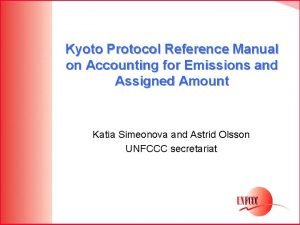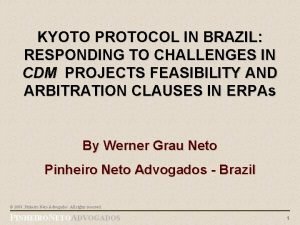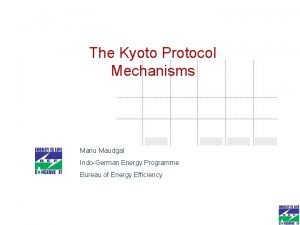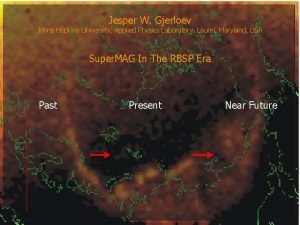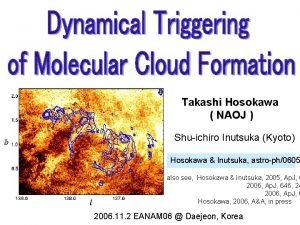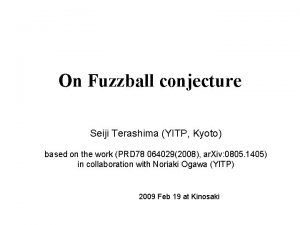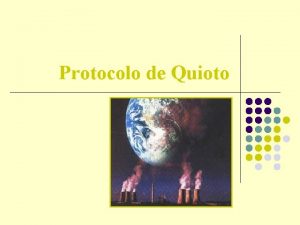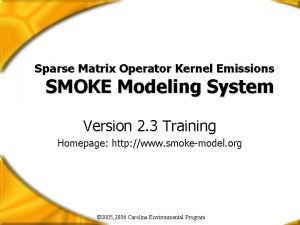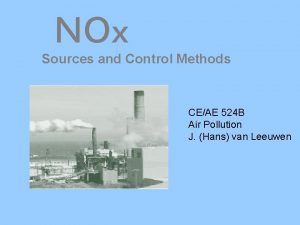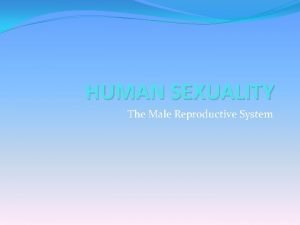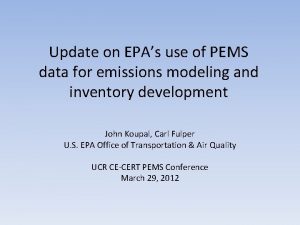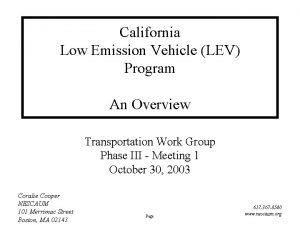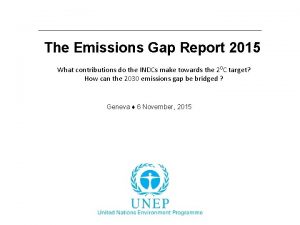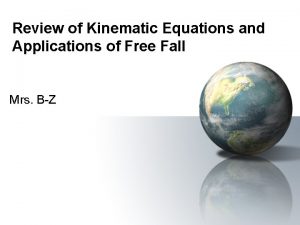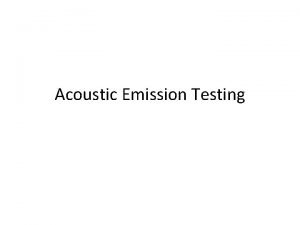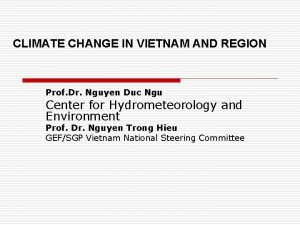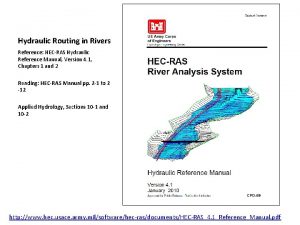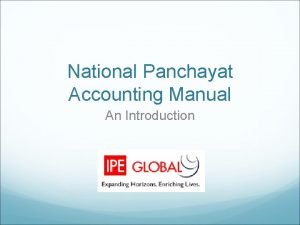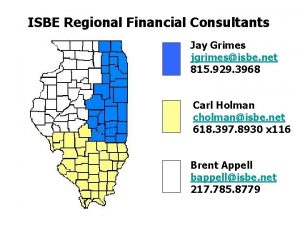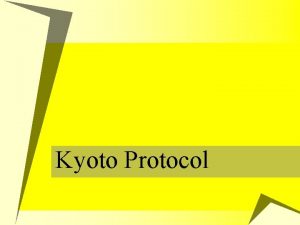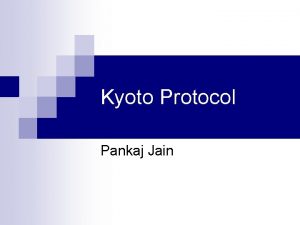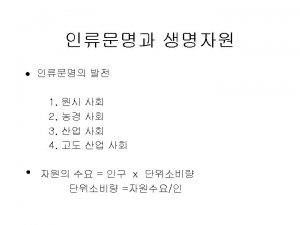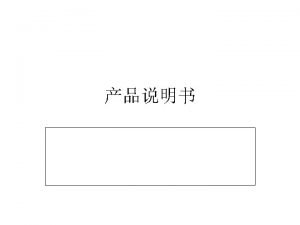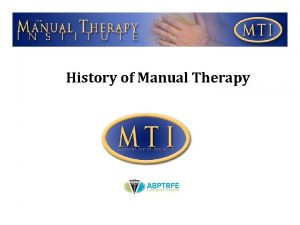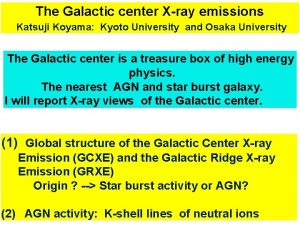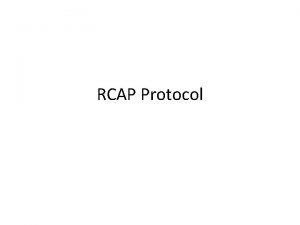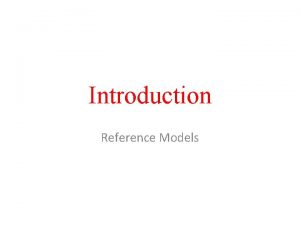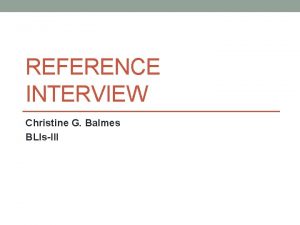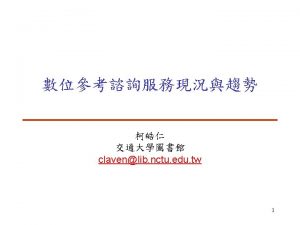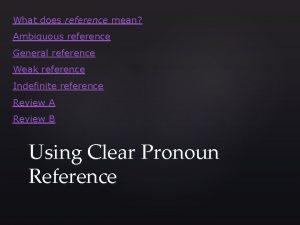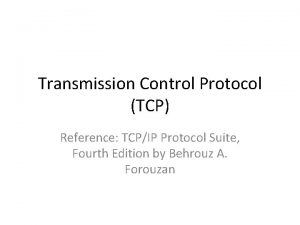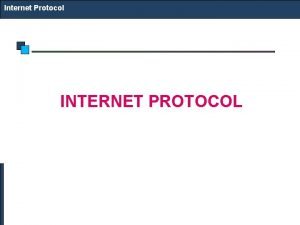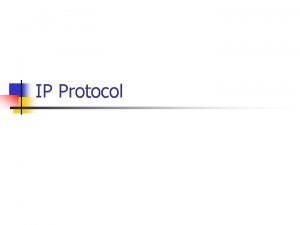Kyoto Protocol Reference Manual on Accounting for Emissions



































- Slides: 35

Kyoto Protocol Reference Manual on Accounting for Emissions and Assigned Amount Katia Simeonova and Astrid Olsson UNFCCC secretariat

Overview l Introduction to Reference Manual ú Objective ú Contents l Role of reporting, review and compliance procedures in accounting of emissions and assigned amount ú Eligibility to participate in the Kyoto Mechanisms ú Accounting prior to, during and end of commitment period l LULUCF Accounting

Why a Reference Manual? l Rules for implementation of the Protocol related to AA are scattered across numerous decisions ú Many inter-linkages ú No comprehensive synthesis l l Many questions from Annex I Parties regarding requirements for implementation of the Protocol Need to facilitate a common, consistent approach by experts and institutions involved in supporting and assessing implementation – ERTs, Compliance Committee, Secretariat

Reference Manual Contents l Overview of Kyoto Protocol and principal commitments ú Particular focus on requirements and systems that relate to accounting of emissions and assigned amounts l l Process for accounting of emissions and assigned amount prior to, during and after commitment period Requirements for participation in the Kyoto Protocol mechanisms ú Eligibility criteria ú Procedures for establishment, maintenance, suspension and reinstatement of eligibility

Reference Manual Contents - continued l Detailed chapters on requirements related to accounting of emissions and assigned amount ú National systems Overview of guidelines Reporting requirements and review process ú GHG inventories Annex A sources versus LULUCF References to KP guidelines and IPCC methodologies Review process and adjustments ú Calculation of assigned amount Rules for calculation Process for establishment l Commitment period reserve

Reference Manual Contents - continued l National Registry ú ú l Overview of data exchange standards Account types Process for conducting transactions Registry testing, initialization and reconciliation procedures Transactions of Kyoto Protocol Units ú Unit Types ú Rules ú Reporting requirements l LULUCF accounting ú Overall accounting approach ú Rules for individual activity ú Reporting requirements

Role of reporting, review and compliance procedures in accounting of emissions and assigned amount

Role of reporting, review and compliance procedures These procedures • Enable establishment, suspension and reinstatement • • • of mechanisms eligibility Verify that Party is accounting of emissions and assigned amount correctly Result in official data for compliance purposes Enable determination of Parties’ compliance with Article 3. 1 commitment at end of commitment period


ERTs l Responsibilities of ERTs with respect to accounting of emissions and assigned amount: ú Review inventories, and where appropriate, recommend application of adjustments ú Review transactions of Kyoto Protocol units and, where appropriate, recommend corrections ú Review implementation of requirements related to mechanisms eligibility ú Raise questions of implementation for consideration by the Compliance Committee

Questions of Implementation Recommended Improvements Unresolved problems (shoulds and shalls) Questions of Implementation (shalls)

Relationship between review & compliance l l All review reports forwarded to Compliance Committee takes up questions of implementation (QUIs) ú Critical that ERT clearly indicate QUIs l Enforcement Branch to consider all QUIs related to accounting of emissions and assigned amount, including mechanisms eligibility

Eligibility to Participate in the Kyoto Mechanisms

Kyoto Mechanisms eligibility requirements l Participation in Kyoto mechanisms dependent on compliance with specific methodological and reporting requirements: ú ú ú Party to the Kyoto Protocol Initial assigned amount established National System in place National Registry in place Annual Inventory Annual information on assigned amount, and accounted correctly

Inventory requirement l Decision 15/CMP. 1 specifies that a Party will fail to meet the annual inventory requirement if and only if: ú Inventory not submitted within 6 weeks of due date ú Omission of Annex A key source that accounts for 7% or more ú ú ú l of annual emissions Total adjustments to Annex A sources in a year of the commitment period exceeds 7% of submitted emissions At any point in time, sum of adjustments across years of the commitment period exceeds 20% compared to submitted An adjustment is applied in three consecutive years to key source that accounts for 2% or more of Annex A emissions Conditions apply to Annex A emissions only

Eligibility Requirements l Same six criteria for each mechanism, but consequences differ by mechanism: ú Emissions trading: Must be in compliance with all requirements to transfer or acquire units ú Joint Implementation: Track one: Must meet all requirements Track two: Must have national registry in order to issue and transfer ERUs ú CDM: Must meet all requirements in order to use CERs, t. CERs and l. CERs

Process for establishing eligibility l l Normal outcome of reporting, review & compliance procedures Automatically eligible 16 months after submission of initial report, unless Enforcement Branch determines at an earlier date that Party fails to meet one or more of the requirements ú Party may also be deemed eligible at earlier date if no questions of implementation regarding an eligibility requirement l Party then remains eligible until and unless Compliance Committee suspends eligibility

Suspension of Eligibility l Will occur if and when Enforcement Branch determines a Party is out of compliance with an eligibility requirement ú Question of implementation regarding eligibility requirement raised in review report Status report for inventory omissions Final annual review report ú Can also occur as result of Party raising a question of implementation regarding another Party

Reinstatement of Mechanisms Eligibility l l Only Enforcement Branch can reinstate eligibility Party can request reinstatement ú Directly to Compliance Committee ú Through the Review Process (expedited review procedures)

Accounting before, during and end of commitment period

Before commitment period Initial Reporting and Review l l Submission and review of initial report leads to ú Establishment of initial assigned amount in tonnes of CO 2 equivalent ú Determination of Party’s eligibility to participate in each of the Kyoto mechanisms Following review and resolution of any QUIs by Compliance Committee, data recorded in compilation and accounting database (CAD) and provided to international transaction log (ITL) ú Party can now issue AAUs ú If eligible, can begin transferring and acquiring Kyoto Protocol units

Annual Reporting 2007 – 2009 l Submission of supplementary information under Article 7, paragraph 1 voluntary under Kyoto Protocol, but required for full eligibility to participate in the Kyoto Mechanisms ú Convention inventory only, KP LULUCF information not yet required (required in 2010) ú Information on holdings and transactions of Kyoto Protocol units reported in the standard electronic format (SEF) required year after Party first transfers or acquires Kyoto Protocol units 2009 for most Parties

Annual Review Tasks 2007 – 2009 l Inventories not subject to adjustment during this period ú However, important for ERT to clearly identify reporting gaps l Review of SEF comparison reports, and ITL discrepancy and inconsistency reports ú ERT may recommend application of a correction l l Review of any reported changes in national system Review of any reported changes in national registry ú Annual independent assessment reports available l Party’s holdings of Kyoto Protocol units recorded annually in CAD, after review and resolution of QUIs ú Compliance with mechanisms eligibility requirements updated as necessary and provided to ITL

Commitment period Annual Reporting 2010 – 2013 l Supplementary information under Article 7, paragraph 1 mandatory for all Annex I Parties: ú GHG inventory must include supplementary information on LULUCF activities (3. 3 and 3. 4) Calculation of the accounting quantity for annually elected activities ú SEF information for previous calendar year ú Changes in national systems and registries ú Information relating to Article 3. 14 Not related to accounting of emissions and assigned amount

Commitment period Annual Review Tasks 2010 – 2013 l Inventory review ú Convention inventory (Annex A sources and LULUCF) ú Article 3. 3 and 3. 4 activities l Adjustments ú May be recommended for emissions from Annex A sources ú May be recommended for LULUCF for activities that are annually accounted l l Review of Party’s calculation of accounting quantity for annually accounted Article 3. 3 and 3. 4 activities Review of AA information and possible recommendation of corrections

Commitment period Annual Review 2010 – 2013 l Information recorded annually in CAD ú Emissions from Annex A sources and any adjustments applied ú LULUCF emissions and any adjustments applied for annually accounted activities ú Holdings and transactions of Kyoto Protocol units ú Compliance with mechanisms eligibility requirements updated as necessary l Parties must issue or cancel units for annually accounted LULUCF activities each year following review and compliance procedures

Annual Reporting 2014 l Final inventory data for commitment period ú Last chance to recalculate emissions and removals l Calculation of the accounting quantity for LULUCF activities for which Party has elected commitment period accounting

Annual Review 2014 l Information recorded in CAD ú Total Annex A emissions for commitment period ú Final accounting quantity for all 3. 3 and 3. 4 activities (annual and CP accounting) l After review and compliance procedures complete for all Parties, ‘true-up period’ begins ú Exact date to be determined by COP/MOP decision ú Final transactions of Kyoto Protocol units Includes all issuance/cancellation for CP-elected LULUCF activities Retirement of sufficient units to cover total Annex A emissions

End of commitment period 2015 Reporting and Review l End of commitment period report ú AA information for 2014 calendar year + true-up period in 2015 ú All units retired for commitment period ú All units that Party wishes to ‘carry-over’ to next commitment period l Review tasks ú Total Annex A emissions ≤ retired units? ú Check units available for carry-over l Compliance determination: ú Deduction of units at 1. 3: 1 for excess emissions ú Suspension of transfer rights for non-compliance l Following review and compliance procedures ú Parties can initiate carry-over of valid units ú Any Party found in non-compliance must cancel units from 2 nd commitment period accounts

Summary of Information in Annual Reports Reporting Element 2007 2008 2009 2010 2011 2012 2013 2014 Convention Inventory ● ● ● ● ● ● KP LULUCF Inventory SEF & AA information Calculation of AQ for Annual LULUCF activities ○ ● Calculation of AQ for CP LULUCF activities 3. 14 Information 2015 (True-up report) ● ● ● ● Units Retired ● Units for carry-over ●

Accounting of LULUCF Activities under Articles 3. 3 and 3. 4

General approach to LULUCF Accounting l Accounting frequency for each 3. 3 activity and each elected 3. 4 activity indicated in Party’s initial report ú For annually elected activities, Party must issue or cancel units corresponding to net removals or net emissions from that activity following review and compliance procedures in each of years 2010 – 2014 ú For commitment period elected activities, Party must issue or cancel units corresponding to net removals or net emissions over the entire commitment period following review and compliance procedures in 2014 only l Parties report Emissions and removals (in KP CRF tables) reported annually, regardless of accounting frequency for the activity Calculation of the ‘accounting quantity’ (AQ) only when activity is accounted

The Accounting Quantity for LULUCF activities l Represents the cumulative obligation to issue or cancel units to date for a given CP year ú A negative AQ indicates cumulative net removals issuance of RMUs ú A positive AQ indicates cumulative net emissions cancellation of units l l For CP-elected activities, AQ will be calculated and reported only once in 2014 For annually-elected activities, AQ will be calculated and reported annually and will capture all emissions and removals to date (e. g. 2011 AQ will be based on net emissions and removals in 2008 and 2009) ú Will capture any recalculations of estimates for previous CP years

Issuance and Cancellation l AQ to be calculated by Party, in accordance with sinks accounting rules and checked by ERT ú Any adjustments applied to emissions and removals for an activity will result in modification of AQ l l AQ will be recorded in CAD and provided to ITL Party’s national registry can then issue or cancel units ú Quantity of units to be issued or cancelled at any point in time depends on AQ, and quantity of units previously issued or cancelled

Thank you For more information contact Ms. Katia Simeonova (ksimeonova@unfccc. int)
 Kyoto protocol reference manual
Kyoto protocol reference manual Kyoto protocol objectives
Kyoto protocol objectives Kyoto protocol brazil
Kyoto protocol brazil Kyoto protocol
Kyoto protocol Manu maudgal
Manu maudgal Kyoto treaty apush
Kyoto treaty apush Combustivels
Combustivels Menguin kyoto
Menguin kyoto Mappa concettuale protocollo di kyoto
Mappa concettuale protocollo di kyoto Kyoto
Kyoto Yitp kyoto
Yitp kyoto Prtocolo de kyoto
Prtocolo de kyoto Wireless interenet
Wireless interenet Protocolo de kyoto
Protocolo de kyoto Volkswagen emissions scandal ethics
Volkswagen emissions scandal ethics Sparse matrix operator kernel emissions
Sparse matrix operator kernel emissions Diesel emissions denver
Diesel emissions denver Sources of nox emissions
Sources of nox emissions Parts of sperm cell
Parts of sperm cell Pems emissions modeling
Pems emissions modeling Where else have you observed colorful light emissions
Where else have you observed colorful light emissions Lev 2 emissions
Lev 2 emissions State of the voluntary carbon markets 2017
State of the voluntary carbon markets 2017 Un emissions gap report
Un emissions gap report Otto emissions is driving his car at 25.0 m s
Otto emissions is driving his car at 25.0 m s Using citys heat reduce emissions
Using citys heat reduce emissions Application of acoustic emission testing
Application of acoustic emission testing Ghs emissions
Ghs emissions Splonc
Splonc Reference node and non reference node
Reference node and non reference node Reference node and non reference node
Reference node and non reference node Hec-ras reference manual
Hec-ras reference manual E commerce accounting principles
E commerce accounting principles Panchayat accounting
Panchayat accounting Dynamics gp analytical accounting manual
Dynamics gp analytical accounting manual Illinois program accounting manual
Illinois program accounting manual
